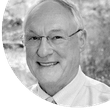

DEPARTMENTS

RISK
CHUCK GERACI, PhD, CIH, FAIHA, is chair of AIHA’s Content Portfolio Advisory Group.
Send feedback to The Synergist.
Risk and Effective Communication
BY CHUCK GERACI
More than ever, our profession is called on to provide information not only to employees and their families, but also employers, the general public, and the media, on wide-ranging and complex issues such as coronavirus, persistent chemicals, derailments, and explosions. Industrial hygienists and OEHS professionals are well qualified to explain issues related to personal protection, facility control, safe return to work and community, and the ongoing challenges of supporting daily occupational and public health. Among the many elements of OEHS that the pandemic has highlighted, the understanding of risk is of primary interest, and therefore one we should be prepared to discuss. But risk is a complicated issue to communicate, and without good tools and skills, OEHS practitioners will not be effective when asked to contribute.
TWO STUDIES
Nearly 20 years ago, AIHA invested in a study to identify key trends that had potential to impact OEHS. From that effort, AIHA developed a strategy for developing content focused on addressing the challenges that had been identified. This effort was later steered by what was known as the Content Portfolio Management Team. CPMT later transitioned into the Content Portfolio Advisory Group, or CPAG, which works with the AIHA Board of Directors, volunteer groups, staff, and the overall membership to maximize AIHA’s content development and meet AIHA’s mission of supporting OEHS practitioners.
In 2019, AIHA refined and updated the initial study. As a result, CPAG updated AIHA’s list of content priorities, which currently includes Big Data and sensor technology, Total Worker Health, serving the changing workforce, and communicating OEHS concepts.
One of the key findings from both studies was that OEHS practitioners can and should improve their skills in effective communication. CPAG subsequently identified the need to develop educational content for OEHS professionals in soft skills, interpersonal skills, stakeholder and decision-maker language, promoting and valuing our professional capacity, and risk characterization and communication.
Too often, the OEHS profession reverts to technical language, quantitative exposure data, statistics, and other forms of technical language that potentially create barriers to effective communication.
For the rubric of risk communication, CPAG created a small working group to identify materials that help OEHS practitioners communicate more effectively with a broad range of audiences in a variety of risk scenarios. One major resource they identified was the work of Peter Sandman, who has written and lectured on the topic of risk communication for over 30 years. AIHA and Sandman have enjoyed a productive relationship that has included multiple articles in The Synergist and publication of Sandman’s Responding to Community Outrage: Strategies for Effective Risk Communication in 1992.
KEY PRINCIPLES
In October 2021, CPAG began a dialogue with Sandman and created another working group to review his work from the perspective of OEHS practitioners. Several key findings surfaced quickly. While the science of risk assessment and the techniques used to communicate risk have evolved over the past 30 years, emotions are central to human decision-making, and, depending on the circumstances, simply relying on objective scientific data may be ineffective. Too often, the OEHS profession reverts to technical language, quantitative exposure data, statistics, and other forms of technical language that potentially create barriers to effective communication.
The materials reviewed by the Sandman working group included principles that are still relevant today to address what Sandman identified as “Risk = Hazard + Outrage.” These key principles are: know your audience; identify common concerns and listen; build trust and credibility; be honest, frank, and open; tell a story; be empathetic and have compassion; involve experts; and keep your message short, simple, and charismatic.
FUTURE WORK
With Sandman’s permission, CPAG plans to develop a searchable index of the major sections of his website with active links to materials relevant to OEHS practitioners. The objective of this effort, which is expected to be completed later this year, is to give more immediate access to content related to risk communication.